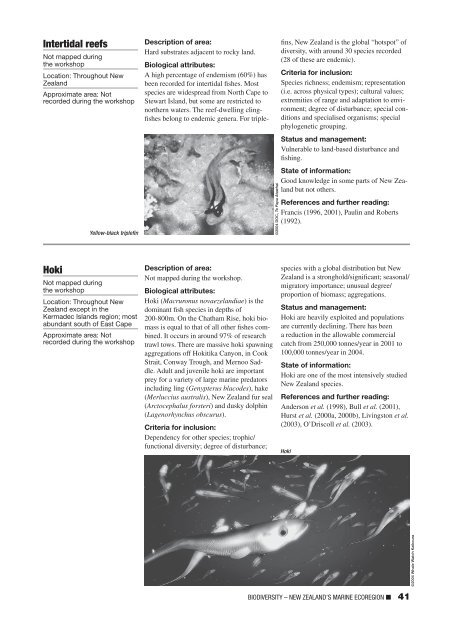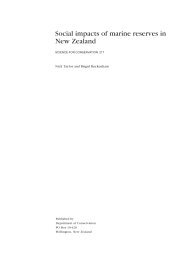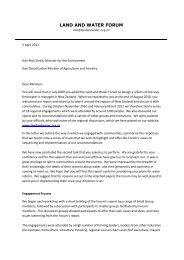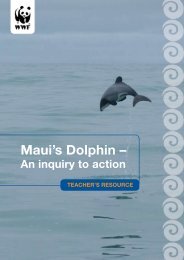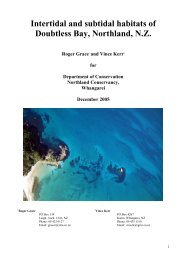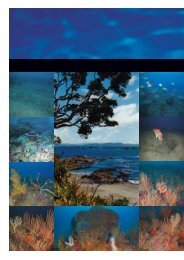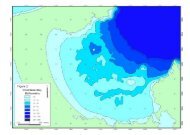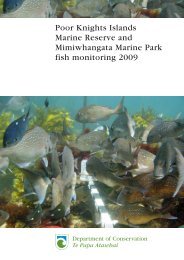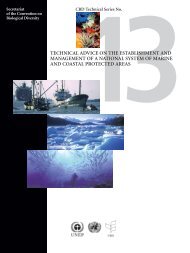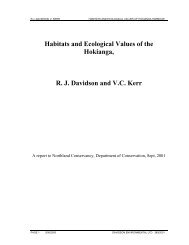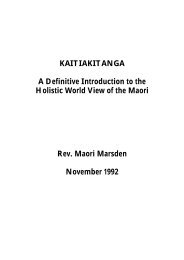WWF Shining a spotlight on the biodiversity of ... - MarineNZ.org.nz
WWF Shining a spotlight on the biodiversity of ... - MarineNZ.org.nz
WWF Shining a spotlight on the biodiversity of ... - MarineNZ.org.nz
You also want an ePaper? Increase the reach of your titles
YUMPU automatically turns print PDFs into web optimized ePapers that Google loves.
Intertidal reefs<br />
Not mapped during<br />
<strong>the</strong> workshop<br />
Locati<strong>on</strong>: Throughout New<br />
Zealand<br />
Approximate area: Not<br />
recorded during <strong>the</strong> workshop<br />
Yellow-black triplefin<br />
©2004 DOC, Te Papa Atawhai<br />
Descripti<strong>on</strong> <strong>of</strong> area:<br />
Hard substrates adjacent to rocky land.<br />
Biological attributes:<br />
A high percentage <strong>of</strong> endemism (60%) has<br />
been recorded for intertidal fishes. Most<br />
species are widespread from North Cape to<br />
Stewart Island, but some are restricted to<br />
nor<strong>the</strong>rn waters. The reef-dwelling clingfishes<br />
bel<strong>on</strong>g to endemic genera. For triplefins,<br />
New Zealand is <strong>the</strong> global “hotspot” <strong>of</strong><br />
diversity, with around 30 species recorded<br />
(28 <strong>of</strong> <strong>the</strong>se are endemic).<br />
Criteria for inclusi<strong>on</strong>:<br />
Species richness; endemism; representati<strong>on</strong><br />
(i.e. across physical types); cultural values;<br />
extremities <strong>of</strong> range and adaptati<strong>on</strong> to envir<strong>on</strong>ment;<br />
degree <strong>of</strong> disturbance; special c<strong>on</strong>diti<strong>on</strong>s<br />
and specialised <strong>org</strong>anisms; special<br />
phylogenetic grouping.<br />
Status and management:<br />
Vulnerable to land-based disturbance and<br />
fishing.<br />
State <strong>of</strong> informati<strong>on</strong>:<br />
Good knowledge in some parts <strong>of</strong> New Zealand<br />
but not o<strong>the</strong>rs.<br />
References and fur<strong>the</strong>r reading:<br />
Francis (1996, 2001), Paulin and Roberts<br />
(1992).<br />
Hoki<br />
Not mapped during<br />
<strong>the</strong> workshop<br />
Locati<strong>on</strong>: Throughout New<br />
Zealand except in <strong>the</strong><br />
Kermadec Islands regi<strong>on</strong>; most<br />
abundant south <strong>of</strong> East Cape<br />
Approximate area: Not<br />
recorded during <strong>the</strong> workshop<br />
Descripti<strong>on</strong> <strong>of</strong> area:<br />
Not mapped during <strong>the</strong> workshop.<br />
Biological attributes:<br />
Hoki (Macrur<strong>on</strong>us novaezelandiae) is <strong>the</strong><br />
dominant fish species in depths <strong>of</strong><br />
200-800m. On <strong>the</strong> Chatham Rise, hoki biomass<br />
is equal to that <strong>of</strong> all o<strong>the</strong>r fishes combined.<br />
It occurs in around 97% <strong>of</strong> research<br />
trawl tows. There are massive hoki spawning<br />
aggregati<strong>on</strong>s <strong>of</strong>f Hokitika Cany<strong>on</strong>, in Cook<br />
Strait, C<strong>on</strong>way Trough, and Mernoo Saddle.<br />
Adult and juvenile hoki are important<br />
prey for a variety <strong>of</strong> large marine predators<br />
including ling (Genypterus blacodes), hake<br />
(Merluccius australis), New Zealand fur seal<br />
(Arctocephalus forsteri) and dusky dolphin<br />
(Lagenorhynchus obscurus).<br />
Criteria for inclusi<strong>on</strong>:<br />
Dependency for o<strong>the</strong>r species; trophic/<br />
functi<strong>on</strong>al diversity; degree <strong>of</strong> disturbance;<br />
species with a global distributi<strong>on</strong> but New<br />
Zealand is a str<strong>on</strong>ghold/significant; seas<strong>on</strong>al/<br />
migratory importance; unusual degree/<br />
proporti<strong>on</strong> <strong>of</strong> biomass; aggregati<strong>on</strong>s.<br />
Status and management:<br />
Hoki are heavily exploited and populati<strong>on</strong>s<br />
are currently declining. There has been<br />
a reducti<strong>on</strong> in <strong>the</strong> allowable commercial<br />
catch from 250,000 t<strong>on</strong>nes/year in 2001 to<br />
100,000 t<strong>on</strong>nes/year in 2004.<br />
State <strong>of</strong> informati<strong>on</strong>:<br />
Hoki are <strong>on</strong>e <strong>of</strong> <strong>the</strong> most intensively studied<br />
New Zealand species.<br />
References and fur<strong>the</strong>r reading:<br />
Anders<strong>on</strong> et al. (1998), Bull et al. (2001),<br />
Hurst et al. (2000a, 2000b), Livingst<strong>on</strong> et al.<br />
(2003), O’Driscoll et al. (2003).<br />
Hoki<br />
©2004 Whale Watch Kaikoura<br />
BIODIVERSITY – NEW ZEALAND’S MARINE ECOREGION ■ 41


